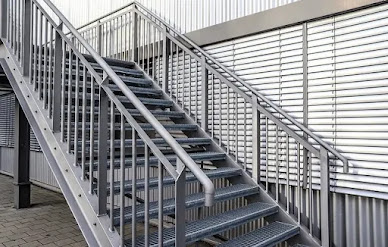A Comprehensive Guide to 7 Stainless Steel Fabrication Methods
Stainless steel is a widely used material across various industries, thanks to its attractive finish, durability, and corrosion resistance. When working with stainless steel, having a thorough understanding of the different fabrication techniques is critical for shaping this versatile metal into custom parts and products. In this guide, we’ll explore some of the most popular methods of stainless steel fabrication in Sydney that are used today.
Cutting
The first step of any stainless steel fabrication process involves cutting the steel to the required dimensions. Working with expert sheet metal supplies in Sydney that offer below value-added fabricating services of stainless orders enables easier purchasing.
● Plasma Cutting: This uses a superheated plasma arc between a constricted electrode nozzle and the workpiece. It can achieve very clean and fast cuts up to 38mm thickness on stainless steel sheets. The heat involved also seals the edges.
● Laser Cutting: A high-power laser accurately cuts the steel by melting and blowing away material. Laser offers high precision and narrow kerf width cuts. It is also easily automated but involves higher equipment costs.
● Waterjet Cutting: In this method, an extremely high-pressure jet of water mixed with abrasives is used to cut through stainless steel parts up to 200mm thick. It produces burr-free and heat-affected-zone free edges.
● Shearing: Here a guillotine-like metal shear machine applies immense pressure to make lengthwise cuts through thin stainless steel sheets. It is fast and economical for high volume sheet metal cutting.
Forming
Forming processes are used to bend or shape sheets of stainless steel into desired contours without any cracks or failures. Some approaches include:
● Press Brake Forming: A common technique where programmed brake presses apply precision bending along the stainless steel sheet’s axis. Several press cycles may be needed to achieve the final shape.
● Roll Forming: This gradually rolls stainless steel coil strips between consecutive roller dies to shape the curves needed for specific profiles. It works well for producing parts in longer lengths.
● Stretch Forming: For tighter bends beyond press brake limits, stretch forming incrementally forms stainless sheets into shape using CNC equipment. It prevents material thinning in bends.
Joining
Joining steel sections together securely is vital where larger and more complex stainless steel fabrication in Sydney is required:
● Welding: Using electric arcs, high heat input welding methods like MIG, TIG, Laser, and Spot can be applied for joining stainless steels. These fusion welds provide full penetration. Low heat methods like resistance welding are also an option. Proper filler metals and protocols are followed to ensure sound welds when working with stainless steels.
● Fasteners: Stainless steel fasteners like bolts, screws and rivets coated with anti-seize can mechanically join stainless fabricated components. This allows non-permanent joining.
● Adhesives: High strength structural adhesives are also effective to bond stainless steel to other metals or itself. This technique enables load distribution over joints.
Polishing
Achieving aesthetically pleasing finishes on fabricated stainless steel surfaces involves polishing and buffing methods like:
● Grinding: Harsh grinding with coarse abrasives rapidly removes surface defects but may leave scratches requiring further polishing with finer grit sizes.
● Buffing: Using buffing wheels and extremely fine abrasive pastes can nicely smooth stainless surfaces and create stunning mirror or brushed looks. Care is taken to avoid overheating.
● Electropolishing: This electrochemical treatment is ideal for removing impurities and smoothing welds. It helps achieve cleaner and more hygienic stainless steel finishes sought after in pharmaceuticals and kitchenware.
● Passivation: Chemical passivation done using nitric acid further removes free iron and other deposits while forming a thin transparent protective chromium oxide layer to boost corrosion resistance.
Coating
Additional coatings can provide supplementary benefits like aesthetics, chemical and abrasion protection:
● Powder Coating: This technique applies powdered paint electrostatically before hardening it with heat to produce a thicker and even coating in a desired color for decorative needs.
● Plastics Coating: For safety and durability in harsh environments, plastic coatings like PTFE Teflon and PVC Vinyl can shield stainless steel surfaces from scratching during usage.
● Anodizing: Anodic oxidation processes help thicken oxide layers on stainless steel surfaces allowing better adhesion for paints and varied colors. It also improves corrosion endurance.
Additive Manufacturing
Modern 3D printing methods now enable stainless steel additive manufacturing which opens new design possibilities:
● Powder Bed Fusion: This 3D prints parts by selectively melting layers of stainless steel powder using a laser or electron beam for superior precision and strength. It is however slower and costlier.
● Directed Energy Deposition: Here focused thermal energy melts metal powder or wire as it gets deposited. This method allows larger and faster prints but with less accuracy. Parts may require post-processing for finish.
Metal Spinning
Spinning makes it possible to form cylindrical and specially curved solids of revolution using stainless steel blanks. Here, a rotating blank held against a form gets precisely shaped using pressure from wheels and tools. With computerised control, complex stainless steel shapes can be mass-produced.
Final Words
By understanding these fundamental fabrication techniques for stainless steel across cutting, forming, joining, finishing and manufacturing stages, the full potential of this high-performance material can be leveraged for innovative products and unique designs across industrial domains. With new advances, stainless steel promises to continue enabling exceptional quality fabrication.
During planning stages, checking with sheet metal supplies in Sydney about item availability, minimum order quantities, and lead times for grade 304 or 316 stainless coils can prevent delays.


Comments
Post a Comment